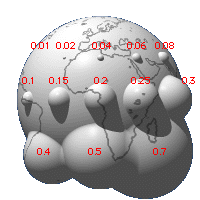|
The inside story of Breathing Earth
The Breathing Earth offers a visualization of compressed earthquake data. Data is included from earthquakes that have occurred worldwide in the past 14 days. The contents take the form of a WWW site filmed with time-lapsed photography.
Currently, on-line data is used from the International Database Center (IDC)(*1). The data includes undefined vibration data by analysts (*2), therefore the earthquake data is not 100% scientifically precise. (Information at the Breathing Earth should not be used for academic purposes as the data is not scientifically consistent.) (*3)
We thank the IDC, and we are impressed with its vast data resources. Please visit the IDC site as well.
Actually, the Earth revolves on its orbit at an extraordinary speed. (Information on the earth's speed can be obtained at the Star Place site.) The Earth's speed fluctuates owing to the centrifugal force of the planet's revolution, the gravitational force of the Moon, and expansion from the spin of the Earth itself.
The Earth is also influenced by a magnetic storm from the sun, and sometimes it passes through a trail of cosmic dust at a tremendous speed. Studies show the axis of the spin changes when an earthquake greater than a magnitude of seven on the Richter scale occurs. (The axis slowly returns to normal.) What a dynamic environment in which we live.
We sigh...how can we be eating, watching a movie, or creating a Web site on the surface of a body of such violently fluctuating energy?
At the sensorium library,
which was written by Shin'ichi Takemura, the sensorium producer, is available. Nobuhiro Furuse, an Earth physician who participated in the creation of the Breathing Earth site, has written an interesting explanation about the vibrating the Earth at his Web site.
If you are interested in the Earth in the sense of a floating world, please read these items.
For information about the Breathing Earth production staff, please see the Staff Page.
Notes:
(*1) The International Database Center (IDC) is an environmental information center supported by the Nuclear Treaty Programs Office (NTPO) and the Advanced Research Projects Agency (ARPA). The center was originally set up to monitor atomic bomb experiments. The IDC's data does not track earthquakes as scientific phenomena. However, we chose the IDC's data because it features more data on earthquakes, particularly those of a low magnitude, than more scientific sites. There are many excellent Web sites concerning earthquakes. USGS (http://g eovax.ed.ac.uk/scratch/quake_all.html) is one of the best.
 (*2) The Breathing Earth uses data the IDC has collected from global earthquake observation networks and eliminates possible noise. (You can access the data under Recent Events at the IDC site.) The IDC data will be studied by analysts worldwide for four dates, then the data will be reported to the Center for Monitoring Research (CMR) as official data for the earthquake. (See the prototype IDC page. Also, see the process of analysis at the IDC's Daily Event Tracking page. To facilitate your understanding, a visual on the PLOT might help you.) (*2) The Breathing Earth uses data the IDC has collected from global earthquake observation networks and eliminates possible noise. (You can access the data under Recent Events at the IDC site.) The IDC data will be studied by analysts worldwide for four dates, then the data will be reported to the Center for Monitoring Research (CMR) as official data for the earthquake. (See the prototype IDC page. Also, see the process of analysis at the IDC's Daily Event Tracking page. To facilitate your understanding, a visual on the PLOT might help you.)
(*3) At the Breathing Earth, a hemisphere indicating the size of the earthquake might not be proportional to the earthquake's magnitude. With each increase of grade in magnitude, the energy released expands 32 or more times.
|
|